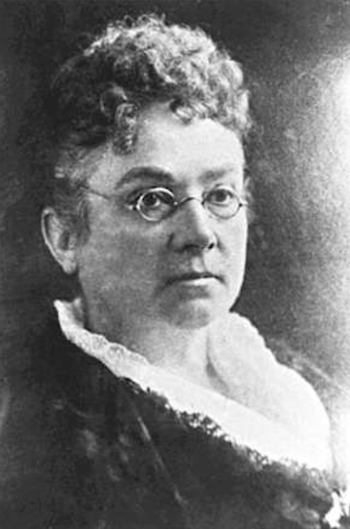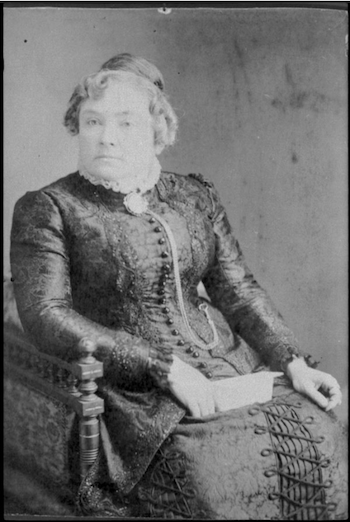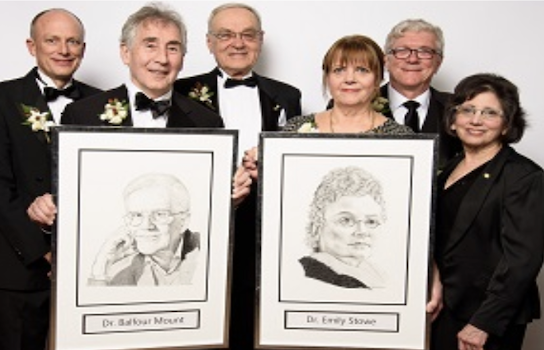
Dr. Emily Howard Jennings Stowe was born on May 1, 1831, in Norwich Township, Oxford County, Ontario, Canada. She is the oldest of her five sisters. Her mother, Hannah Lossing Howard, and her father, Solomon Jennings, were successful farmers and Quakers. Both of her parents were raised in the United States and then moved to Canada for a better future. They were also spiritual and political leaders in their community. In addition, Stowe was raised in a community that was known for its egalitarian ideals and encouraged women’s education and women’s participation in Quaker meetings. Her mother homeschooled her and her siblings, which developed Dr. Stowe’s passion for learning. Her mother also taught them herbal healing and Stowe developed an interest in medicine when she began learning from a family friend, Joseph J. Lancaster, who was a homeopathic physician. He treated people using highly diluted substances in the form of pills or liquids.
In her early adolescence, Stowe worked as an apprentice under Lancester’s supervision in addition to working on her family farm. Furthermore, at only 15 years old, Stowe was employed as a teacher in the town of Summerville, Ontario, where she worked for seven years. In 1852, she applied to Victoria College in Cobourg, Ontario, but was rejected solely because of her gender. This rejection redirected her to applying to the Normal School for Upper Canada (Toronto) in 1853; it was the only advanced Canadian school that accepted women, and she graduated in 1854 with first-class honors. Upon graduation, she was accepted to be a principal at Brantford School Board, making history for being the first female principal of an Ontario public school, where she worked for two years.
On November 22, 1856, she married John Stowe, who ran his family business called the Stowe Brothers Carriage Stop. They lived together in a small village close to Banford in Mount Pleasant, Ontario. They had a daughter, Ann Agusta, and two sons, John Howard and Frank Jennings Stowe. Unfortunately, in 1863, Stowe’s husband became extremely ill with tuberculosis, but Stowe was able to use her past herbal training skills to treat him. This life-or-death event inspired Stowe to further advance her knowledge and training in herbal healing and medicine; she made it her goal to become a doctor. Stowe started to work again through a teaching position at a local grammar school and began to research places to study medicine.
In 1865, Stowe got rejected from Toronto School of Medicine as women were not allowed into Canadian medical schools at that time. Her only other choice was to study medicine in New York at the New York Medical College for Women, which also taught homeopathic healing. She decided to temporarily leave Canada to pursue her medical dreams while her sister, Cornelia Lossing, looked after her children. She received her degree in 1867. After returning to Canada, she opened a medical practice on Richmond Street in Toronto, becoming the first female physician to practice medicine in Canada. She began drawing attention from the public through newspaper advertisements and giving public lectures on women’s health. In 1869, she applied to the University of Toronto to further obtain her medical license in Canada but got rejected once again due to her gender. However, she was not discouraged and continued to battle the rampant misogyny in the Canadian education system through persistent determination to practice medicine without a medical license. In 1871, she and another woman, Jennie Trout, were finally admitted into the University of Toronto School of Medicine, becoming the first women to attend classes there; they were granted special access by fighting the misogyny, and that foreign practitioners, people who don’t own a medical license or medicine degree in Canada, needed to take an exam inorder maintain this medical license to practice medicine in Canada. However, for unknown reasons, Stowe left the school and continued to practice medicine without a license for over a decade.

In 1879, Stowe was involved in a criminal trial. She was accused of trying to help one of her patients, a nineteen year old named Sarah Lovell, have an abortion, which was illegal at that time. Stowe justified that she had only given her one thirtieth of a full dose, which wasn’t enough to cause a miscarriage. During her testimony at the inquest, Stowe proved herself as a skilled, hardworking and talented medical practitioner. The coroner’s jury concluded that Lovell died from poisoning instead. However, Stowe was criminally charged for administering drugs leading to an abortion, which led to another trial where she was ultimately acquitted. This trial further placed her in the public eye, and soon after, Stowe received her medical license from the College of Physicians and Surgeons of Ontario on July 16, 1880. Instead of taking the traditional route, she got her license through her credentials and past medical work as an apprentice to Dr. Joseph J. Lancaster.
Through her experience with gender discrimination in her medical career, Stowe fought for women’s rights and gender equality; she believed that Canadian women deserve to have as much higher education as men. From 1876 to 1877, she opened a Toronto Women’s Literary Club (TWLC) and was later renamed as the Canadian Women’s Suffrage Association (CWSA) in 1883. The organization's mission was to help women gain access to higher education along with enhancing working conditions and rights of female workers. It later began to publicly support women’s rights to vote and to own property, marking the beginning of the Women’s Suffrage Movement, a movement demanding for women’s right to vote and right to political participation In 1889, she founded another organization devoted to women’s suffrage called the Dominion Women’s Enfranchisement Association (DWEA). As the first president and founder of DWEA, Stowe used many strategies like petitions, lobbying, rallies, speeches, and newspaper editorials to influence political change. Furthermore, perhaps her biggest accomplishment was creating the Women’s Medical College in Toronto in 1883, the first medical college opened specifically for women in Canada. In 1895, it was renamed as the Ontario Medical College for Women. Two years later, the center opened “The Dispensary,” which provided free medical advice and services for patients, regardless of their ability to finance the cost.

After years of advocacy, Stowe died on April 10th, 1903 from unknown reasons, and the Ontario Medical College for women closed in 1905. However, her legacy continues to strive and inspire many Canadian women, such as her daughter Augusta who became the first woman to graduate from a Canadian medical school, the University of Toronto School of Medicine, in 1883. She also inspired a group called the Women’s College Hospital Committee to campaign for a female-run hospital in 1909. In 1911, the group succeeded and the Women’s College Hospital became Canada’s first women lead hospital in history. In 1913, it was renamed as the Women’s College Hospital and Dispensary, which still exists today and is now affiliated with the University of Toronto; it continues to promote innovation and equity in the healthcare industry, leading to astonishing feats, like 128 women becoming first-generation of doctors within 22 years of its establishment. Furthermore, her legacy led to having two elementary schools named after her in Ontario: Emily Stowe Public School in Norwich and Dr. Emily Stowe Public School in Courtice. In 2018, she was admitted into the Canadian Medical Hall of Fame.
Stowe’s hardwork and determination was the start of the Suffrage Movement in Canada, and began a snowball effect of remarkable and historical feminist movements in Canadian history. The freedom and independence that Canadian women have today would not be present without Dr. Stowe’s hard work. Her perseverance is a symbol of hope for women to defy expectations and continue fighting for their dreams in male-dominated fields.
Why Did I Choose to Research Dr. Emily Howard Jennings Stowe?
As a Canadian-immigrant, I decided to research Dr. Stowe as a tribute to her efforts that ultimately allowed Canadian women to earn their right to higher education. I wouldn’t have the rights that I have today without her determination for women’s access to health education. The Women’s College Hospital inspired by Dr. Stowe is affiliated with the University of Toronto, which is the same University that I attend, and it has inspired me to make her story known to young women throughout the world.
Works Cited
140th Anniversary of Woman’s Medical College. (2023, September 14). Women’s College Hospital. https://www.womenscollegehospital.ca/140th-anniversary-of-womans-medical-college/
Breaking barriers: The trailblazing legacy of Dr. Emily Stowe. NCRI Women Committee. (2025, April 1). https://wncri.org/2021/04/29/women-in-history-30-april/
Emily Stowe, MD. Canadian Medical Hall of Fame . (n.d.). https://www.cdnmedhall.ca/laureates/emilystowe
Homeopathy. (2025). Alberta.ca. https://myhealth.alberta.ca/Health/pages/conditions.aspx?hwid=aa104729spec
Raymond, K. (2008, April 1). Emily Stowe. The Canadian Encyclopedia. https://www.thecanadianencyclopedia.ca/en/article/emily-stowe
Emily Jennings stowe early woman doctor in Toronto, Ontario. KARA. (n.d.). https://kawarthagenealogy.ca/celebrate-our-heritage/advertising-marketing/doctor-emily-howard-stowe/
This article was published on 07/14/25